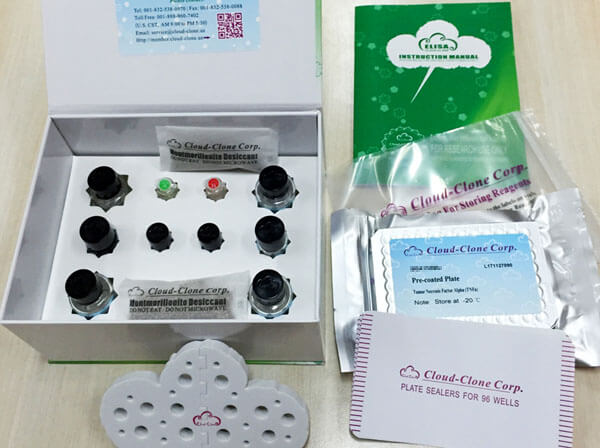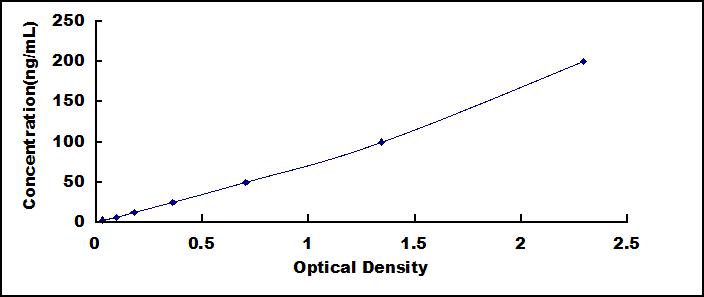ELISA Kit for Lipopolysaccharide Binding Protein (LBP) 

LPS-Binding Protein
- UOM
- FOB US$ 466.00 US$ 665.00 US$ 2,993.00 US$ 5,653.00 US$ 46,550.00
- Quantity
Overview
Properties
- Product No.SEB406Hu
- Organism SpeciesHomo sapiens (Human) Same name, Different species.
- ApplicationsEnzyme-linked immunosorbent assay for Antigen Detection.
Research use only - DownloadInstruction Manual
- CategoryInfection immunity
Sign into your account
Share a new citation as an author
Upload your experimental result
Review

Contact us
Please fill in the blank.
Recovery
Matrices listed below were spiked with certain level of recombinant Lipopolysaccharide Binding Protein (LBP) and the recovery rates were calculated by comparing the measured value to the expected amount of Lipopolysaccharide Binding Protein (LBP) in samples.
| Matrix | Recovery range (%) | Average(%) |
| serum(n=5) | 78-94 | 90 |
| EDTA plasma(n=5) | 98-105 | 102 |
| heparin plasma(n=5) | 79-93 | 87 |
Precision
Intra-assay Precision (Precision within an assay): 3 samples with low, middle and high level Lipopolysaccharide Binding Protein (LBP) were tested 20 times on one plate, respectively.
Inter-assay Precision (Precision between assays): 3 samples with low, middle and high level Lipopolysaccharide Binding Protein (LBP) were tested on 3 different plates, 8 replicates in each plate.
CV(%) = SD/meanX100
Intra-Assay: CV<10%
Inter-Assay: CV<12%
Linearity
The linearity of the kit was assayed by testing samples spiked with appropriate concentration of Lipopolysaccharide Binding Protein (LBP) and their serial dilutions. The results were demonstrated by the percentage of calculated concentration to the expected.
| Sample | 1:2 | 1:4 | 1:8 | 1:16 |
| serum(n=5) | 83-96% | 86-96% | 80-92% | 95-105% |
| EDTA plasma(n=5) | 89-101% | 91-104% | 78-99% | 98-105% |
| heparin plasma(n=5) | 93-105% | 87-101% | 89-96% | 86-101% |
Stability
The stability of kit is determined by the loss rate of activity. The loss rate of this kit is less than 5% within the expiration date under appropriate storage condition.
To minimize extra influence on the performance, operation procedures and lab conditions, especially room temperature, air humidity, incubator temperature should be strictly controlled. It is also strongly suggested that the whole assay is performed by the same operator from the beginning to the end.
Reagents and materials provided
| Reagents | Quantity | Reagents | Quantity |
| Pre-coated, ready to use 96-well strip plate | 1 | Plate sealer for 96 wells | 4 |
| Standard | 2 | Standard Diluent | 1×20mL |
| Detection Reagent A | 1×120µL | Assay Diluent A | 1×12mL |
| Detection Reagent B | 1×120µL | Assay Diluent B | 1×12mL |
| TMB Substrate | 1×9mL | Stop Solution | 1×6mL |
| Wash Buffer (30 × concentrate) | 1×20mL | Instruction manual | 1 |
Assay procedure summary
1. Prepare all reagents, samples and standards;
2. Add 100µL standard or sample to each well. Incubate 1 hours at 37°C;
3. Aspirate and add 100µL prepared Detection Reagent A. Incubate 1 hour at 37°C;
4. Aspirate and wash 3 times;
5. Add 100µL prepared Detection Reagent B. Incubate 30 minutes at 37°C;
6. Aspirate and wash 5 times;
7. Add 90µL Substrate Solution. Incubate 10-20 minutes at 37°C;
8. Add 50µL Stop Solution. Read at 450nm immediately.

Test principle
The test principle applied in this kit is Sandwich enzyme immunoassay. The microtiter plate provided in this kit has been pre-coated with an antibody specific to Lipopolysaccharide Binding Protein (LBP). Standards or samples are then added to the appropriate microtiter plate wells with a biotin-conjugated antibody specific to Lipopolysaccharide Binding Protein (LBP). Next, Avidin conjugated to Horseradish Peroxidase (HRP) is added to each microplate well and incubated. After TMB substrate solution is added, only those wells that contain Lipopolysaccharide Binding Protein (LBP), biotin-conjugated antibody and enzyme-conjugated Avidin will exhibit a change in color. The enzyme-substrate reaction is terminated by the addition of sulphuric acid solution and the color change is measured spectrophotometrically at a wavelength of 450nm ± 10nm. The concentration of Lipopolysaccharide Binding Protein (LBP) in the samples is then determined by comparing the O.D. of the samples to the standard curve.
Giveaways
Increment services
-
 Single-component Reagents of Assay Kit
Single-component Reagents of Assay Kit
-
 Lysis Buffer Specific for ELISA / CLIA
Lysis Buffer Specific for ELISA / CLIA
-
 Quality Control of Kit
Quality Control of Kit
-
 ELISA Kit Customized Service
ELISA Kit Customized Service
-
 Disease Model Customized Service
Disease Model Customized Service
-
 Serums Customized Service
Serums Customized Service
-
 TGFB1 Activation Reagent
TGFB1 Activation Reagent
-
 Real Time PCR Experimental Service
Real Time PCR Experimental Service
-
 Streptavidin
Streptavidin
-
 Fast blue Protein Stain solution
Fast blue Protein Stain solution
-
 Single-component Reagents of FLIA Kit
Single-component Reagents of FLIA Kit
-
 Streptavidin-Agarose Beads
Streptavidin-Agarose Beads
Citations
- A Marker of Endotoxemia Is Associated With Obesity and Related Metabolic Disorders in Apparently Healthy ChineseDiabetes: source
- Oral serum-derived bovine immunoglobulin improves duodenal immune reconstitution and absorption function in patients with HIV enteropathyPubMed: PMC3754419
- Gut microbiome composition is linked to whole grain-induced immunological improvementsPubmed: 23038174
- High ambient temperature alleviates the inflammatory response and growth depression in pigs challenged with Escherichia coli lipopolysaccharidePubmed: 24792207
- The effect of normovolemic modified ultrafiltration on inflammatory mediators, endotoxins, terminal complement complexes and clinical outcome in high-risk cardiac surgery patientsPubmed: 23429100
- A gut microbiota-targeted dietary intervention for amelioration of chronic inflammation underlying metabolic syndrome.Pubmed: 24117923
- Frequency and Severity of Cirrhotic Cardiomyopathy and Its Possible Relationship with Bacterial EndotoxemiaPubmed: 23907333
- Circulating pathogen associated molecular pattern – Binding proteins and High Mobility Group Box protein 1 in nascent metabolic syndrome: Implications for cellular Toll-like receptor activityPubmed:25063948
- Identification of plasma protein markers common to patients with malignant tumour and Abnormal Savda in Uighur medicine: a prospective clinical studyPubmed:25652121
- Increased adipose tissue secretion of Fetuin-A, lipopolysaccharide-binding protein and high-mobility group box protein 1 in metabolic syndromePubMed: 25978344
- Systemic levels of human β-defensin 1 are elevated in patients with cirrhosisPubMed: 26751578
- Comparative proteomics of milk fat globule membrane in goat colostrum and mature milkPubmed:27173528
- High serum lipopolysaccharide binding protein is associated with increased mortality in patients with decompensated cirrhosispubmed:27712029
- Modulation of gut microbiota and gut-generated metabolites by bitter melon results in improvement in the metabolic status in high fat diet-induced obese rats10.1016/j.jff.2017.12.050
- Adamdec1, Ednrb and Ptgs1/Cox1, inflammation genes upregulated in the intestinal mucosa of obese rats, are downregulated by three probiotic strains.pubmed:28512356
- A standardized extract of the fruit of Hovenia dulcis alleviated alcohol-induced hangover in healthy subjects with heterozygous ALDH2: A randomized, controlled, crossover trial.pubmed:28750942
- On a Western diet, APOE ɛ4 is associated with low innate immune sensing, but not APOE ɛ3Pubmed:29928926
- Influence of yeast culture and feed antibiotics on ruminal fermentation and site and extent of digestion in beef heifers fed high grain rationsPubmed:30060086
- Using ruminally protected and nonprotected active dried yeast as alternatives to antibiotics in finishing beef steers: growth performance, carcass traits, blood …Pubmed: 30184125
- Evaluation of the effect of Lactobacillus reuteri V3401 on biomarkers of inflammation, cardiovascular risk and liver steatosis in obese adults with metabolic …Pubmed: 30453950
- Oridonin protects LPS-induced acute lung injury by modulating Nrf2-mediated oxidative stress and Nrf2-independent NLRP3 and NF-κB pathways
- High-dose Glycerol Monolaurate Up-Regulated Beneficial Indigenous Microbiota without Inducing Metabolic Dysfunction and Systemic Inflammation: New Insights …
- Ruminally protected and unprotected Saccharomyces cerevisiae fermentation products as alternatives to antibiotics in finishing beef steersPubmed: 31410465
- Lactobacillus reuteri V3401 Reduces Inflammatory Biomarkers and Modifies the Gastrointestinal Microbiome in Adults with Metabolic Syndrome: The PROSIR StudyPubmed: 31370223
- Effects of sinomenine in LPS‐associated diseases are related to inhibition of LBP, Mac‐1, and L‐selectin levelsPubmed: 31490576
- Needle-shaped amyloid deposition in rat mammary gland: evidence of a novel amyloid fibril proteinPubmed: 31615282
- Ethanol Extract of Propolis Prevents High-Fat Diet-Induced Insulin Resistance and Obesity in Association with Modulation of Gut Microbiota in MicePubmed: 32156386
- Gut microbiota from coronary artery disease patients contributes to vascular dysfunction in mice by regulating bile acid metabolism and immune activationPubmed: 33036625
- Oxidation of fish oil exacerbates alcoholic liver disease by enhancing intestinal dysbiosis in micePubmed: 32879433
- Antibiotic Treatment Reduces the Health Benefits of Soy ProteinPubmed: 32729948
- Highly Branched RG-I Domain Enrichment are Indispensable for Pectin Mitigating Against High-Fat Diet-Induced ObesityPubmed: 32633953
- Molecular characterization and expression analysis of chemokine (CXCL12) from Nile tilapia (Oreochromis niloticus)Pubmed: 32540504
- Tandem Mass Tag (TMT)-based quantitative proteomics reveals potential targets associated with onset of Sub-clinical Mastitis in cowsPubmed: 32518370
- Corneal epithelial injury-induced norepinephrine promotes Pseudomonas aeruginosa keratitisPubmed: 32376471
- Naringin Attenuates High Fat Diet Induced Non-alcoholic Fatty Liver Disease and Gut Bacterial Dysbiosis in Mice
- Umbilical cord mesenchymal stem cells (hUCMSCs) for inflammatory regulation after excision and grafting of severe burn wounds in rats33313794
- Processing Index of Barley Grain and Dietary Undigested Neutral Detergent Fiber Concentration Affected Chewing Behavior, Ruminal pH and Total Tract Nutrient?¡33474564
- Influence of a Biotechnologically Produced Oyster Mushroom (Pleurotus sajor-caju) on the Gut Microbiota and Microbial Metabolites in Obese Zucker Rats33497213
- Melatonin alleviates Ochratoxin A-induced liver inflammation involved intestinal microbiota homeostasis and intestinal microbiota-independent manner33582472
- Studies on Mastitis Caused by Translocated-Bacterial Components in Ruminants
- Monocyte transcriptomes from patients with axial spondyloarthritis reveal dysregulated monocytopoiesis and a distinct inflammatory imprint34560894
- Composition and Functions of the Gut Microbiome in Pediatric Obesity: Relationships with Markers of Insulin Resistance34361925
- The Prebiotic Potential of Geraniin and Geraniin-Enriched Extract against High-Fat-Diet-Induced Metabolic Syndrome in Sprague Dawley RatsPubmed:35453317
- Elucidating the role of the gut microbiota in the physiological effects of dietary fiberPubmed:35562794
- Local free fatty acids trigger the expression of lipopolysaccharide-binding protein in murine white adipose tissuePubmed:35433160
- Сorrelation between the level of 25 (OH) D3 in blood, the content of antimicrobial peptides in oral fluid and dental caries intensity in young individuals








